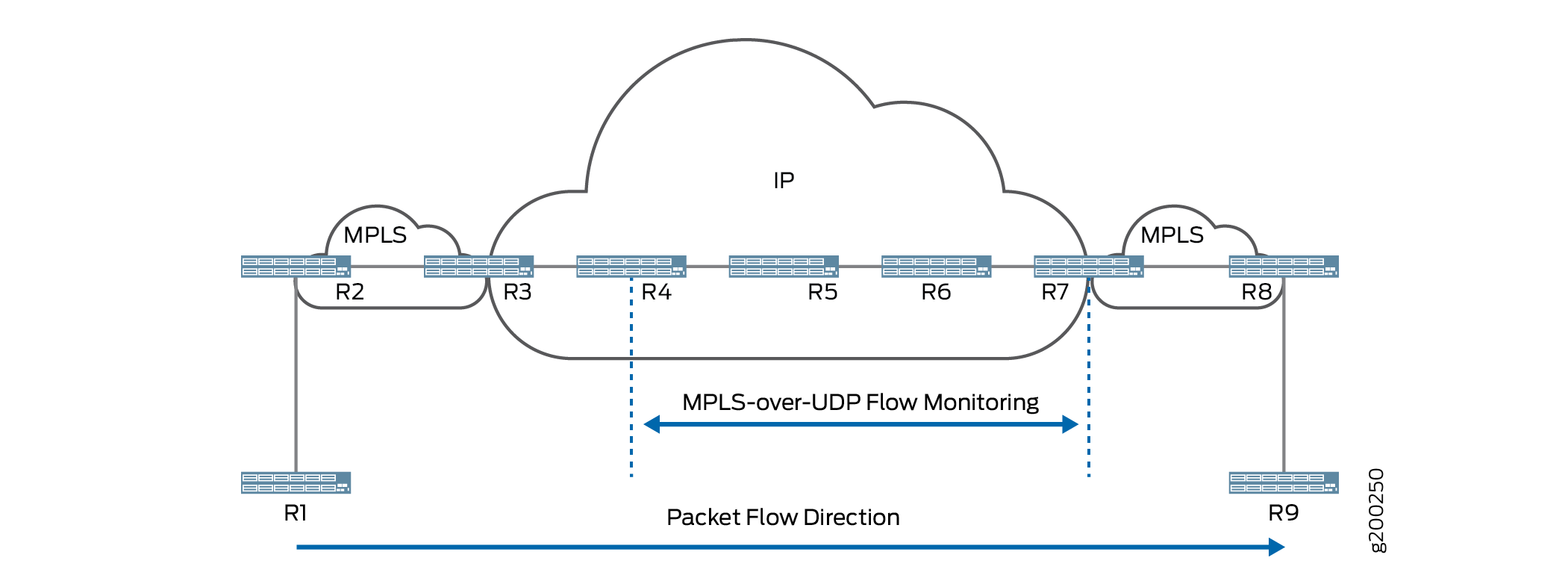Inline Active Flow Monitoring of MPLS-over-UDP Flows on PTX Series Routers
You can enable inline active flow monitoring that reports the inner payload of MPLS-over-UDP flows on PTX Series routers and QFX10002-60C switches.
MPLS-over-UDP Flow Monitoring Overview
Starting with Junos OS Release 18.1R1 on PTX Series routers with an FPC3, PTX10K-LC1101, PTX10K-LC1102, or PTX1000 card, you can perform inline active flow monitoring for MPLS-over-UDP flows to look past the tunnel header to sample and report on the inner payload at both the transit and egress nodes of the tunnel.
Starting with Junos OS Release 19.4R1, on the PTX10002-60C, you can perform inline active flow monitoring for MPLS-over-UDP flows to look past the tunnel header to sample and report on the inner payload at both the transit and egress nodes of the tunnel.
Starting with Junos OS Release 19.4R1, the PTX10002-60C supports inline active flow monitoring for MPLS, MPLS-IPv4, MPLS-IPv6, and MPLS-over-UDP traffic. Both IPFIX and version 9 templates are supported.
Starting with Junos OS Release 21.2R1, the QFX10002-60C supports inline active flow monitoring for MPLS, MPLS-IPv4, MPLS-IPv6, and MPLS-over-UDP traffic. Both IPFIX and version 9 templates are supported.
For a description of the fields included in the templates, see Understand Inline Active Flow Monitoring. Only ingress sampling is supported.
MPLS-over-UDP is not supported on the PTX10001-36MR, PTX10003, PTX10004, and PTX10008 (with the JNP10008-SF3) routers.
Benefits of Using MPLS-Over-UDP Flow Monitoring
-
Gather and export detailed information on even the original IPv4 or IPv6 payload of the MPLS-over-UDP flow.
Flow Monitoring Scenarios for MPLS-over-UDP
Monitoring for MPLS-over-UDP tunnels includes the following scenarios:
-
The MPLS-over-UDP flow is carried through a full IP network, using IPv4 endpoints on PTX Series routers (see Figure 1). The inner payload may be IPv4 or IPv6. Figure 2 shows the encapsulated packet. Flow monitoring reports the inner IP header and payload, in addition to the tunnel and MPLS fields.
You can enable ingress monitoring for the MPLS-over-UDP tunnel at its transit and egress nodes. For example, in Figure 1, you can enable ingress monitoring on routers R4, R5, R6, and R7.
Figure 1: MPLS-over-UDP in Full IP Network Figure 2: Encapsulated Packet for MPLS-over-UDP in Full IP Network
Figure 2: Encapsulated Packet for MPLS-over-UDP in Full IP Network
-
The MPLS-over-UDP flow is carried through an IP-MPLS-IP network, using IPv4 endpoints on PTX Series routers (see Figure 3). The inner payload may be IPv4 or IPv6. In the inner MPLS network, the MPLS-over-UDP flow is encapsulated in an RSVP-TE label-switched path (LSP). Figure 4 shows the encapsulated packet. Flow monitoring reports the inner IP header and payload, in addition to the RSVP label, tunnel, and MPLS fields.
You can enable ingress monitoring for the MPLS-over-UDP tunnel at its transit and egress nodes. For example, in Figure 3, you can enable ingress monitoring on routers R4, R5, R6, R7, R8, and R9.
Figure 3: MPLS-over-UDP Over IP-MPLS-IP Network Figure 4: MPLS-over-UDP in RSVP-TE LSP Packet
Figure 4: MPLS-over-UDP in RSVP-TE LSP Packet
Configuring Inline Active Flow Monitoring of MPLS-over-UDP Flows
(Junos OS only) Configuring inline active monitoring of MPLS-over-UDP flows includes the following tasks:
- Configuring the Template to Specify Output Properties
- Configuring the Sampling Instance
- Assigning the Sampling Instance to an FPC
- Configuring a Firewall Filter
- Assigning the Firewall Filter to the Monitored Interface
Configuring the Template to Specify Output Properties
Configure a template to specify the output properties for the flow records:
Configuring the Sampling Instance
Configure a sampling instance:
Assigning the Sampling Instance to an FPC
[edit chassis] user@host# set fpc slot-number sampling-instance instance-name
Configuring a Firewall Filter
Configure a firewall filter to accept and sample MPLS traffic.
Assigning the Firewall Filter to the Monitored Interface
[edit interfaces] user@host# set interface-name unit logical-unit-number family mpls filter input filter-name
Change History Table
Feature support is determined by the platform and release you are using. Use Feature Explorer to determine if a feature is supported on your platform.
